With the Japanese surrender on Aug. 15, 1945, Korea emerged from 36 years of forced servitude, only to be placed under a trusteeship controlled by the major powers, with Russia controlling the North and the U.S. controlling the South. Koreans were very skeptical of Western intentions. They understood that: the Korean American Treaty of 1882, the International Peace Conference at The Hague in 1907, and Woodrow Wilson’s Fourteen Points of 1918 had all failed in stopping Japanese aggression on the Korean Peninsula. There was also the collusion involved with the Anglo-Japanese Treaties and the Taft-Katsura Treaty. Little stock was placed in the ambiguity of the 1943 Cairo Declaration, which stated that; “The aforesaid three great powers, mindful of the enslavement of the people of Korea, are determined that in due course shall become free and independent.”
Koreans were also aware that the United States enacted the Philippine Autonomy Act of 1916 (A.K.A. The Jones law), promising eventual self-government, then superseded it with the Tydings–McDuffie Act of 1934 (A.K.A. The Philippine Commonwealth and Independence Act). The U.S. Immigration Act of 1924 (The Johnson-Reed Act) completely excluded immigrants from Asia, however since the Philippines was a U.S. colony, its citizens were U.S. nationals and could travel freely to the United States. This all changed under the Tydings-McDuffie Act of 1934. As a U.S. colony, the Filipinos owed their allegiance to the United States, but were not U.S. citizens, and the 1934 Act suddenly set a maximum immigration quota from the Philippines at only 50 individuals per year.
The Korean Peninsula below the 38th Parallel was administered by the U.S. Army Military Government in Korea, better known as USAMGIK (미군정, 美軍政). From the very beginning, USAMGIK was neither popular nor effective. The Japanese colonial government had been highly efficient, and Lt. General John Reed Hodge (1893-1963) tried to utilize this existing machinery in the administration of the Korean peninsula. In a directive to Brigadier General Charles Haris, the Acting Deputy for the Military government of Korea, General Hodge stated: “…it will be necessary, at least initially, to operate through the existing government; therefore the present government of Korea will be recognized as the lawful government.”
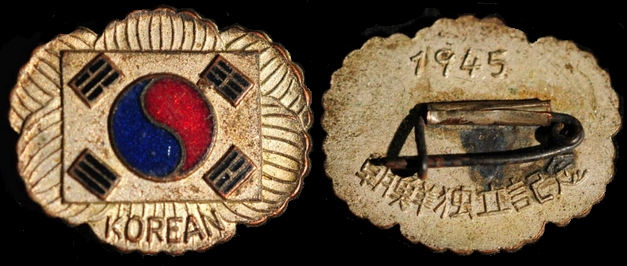
Notice that the Korean flag is not correctly oriented. The Taeguk is always in a superior position above the blue, and the three solid Trigram lines should be in the upper-left corner.
Picture source : Aucfan, a Japanese Auction house.
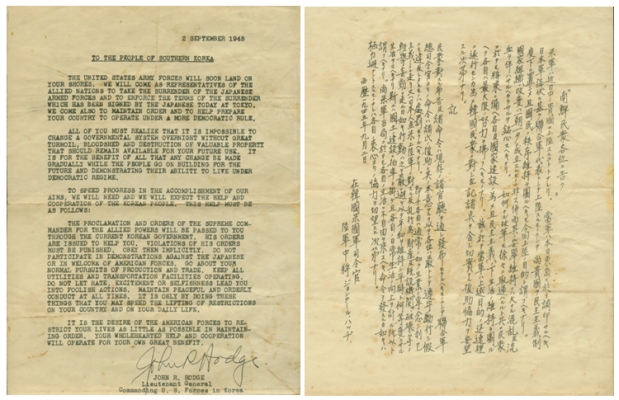
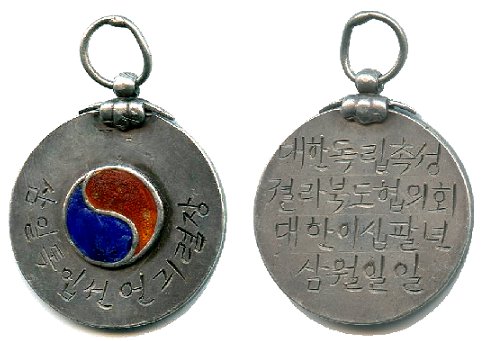
삼일독입선언긔렴장 March 1st Declaration of Independence
Reverse
대한독립촉성 Korean Independence Promotion
졀라북도협의회 Jeollabuk-do Council
대한이십팔년 삼월일일 28 years since March 1st (1919)
Notice that the barrel/claw suspension is virtually identical to those used on the Orders and Medals of the Korean Empire.
1949 Prewar Military Awards
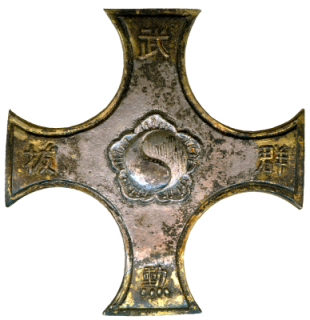
武勳拔群章 (무훈발군장)
On July 15th, 1949, the Korean Department of Defense announced the establishment of a temporary system of Military Awards until a more permanent group of medals could be officially instituted by the central government. According to the newspaper article below, this temporary group had 5 different awards, namely: a Distinguished War Service Medal (upper left), a Distinguished Service Cross (upper right), a Special Wound Medal for permanent disability (center right), a Standard Wound Medal (lower left) and the War Service Medal (lower right). Unfortunately, this newspaper article only tells part of the story.1
In June 1949, Major General Edgar Erskine Hume (1889-1952) was made Director General of Medical Services for the U. S. Far East Command under General Douglas MacArthur. The nature of his work required extensive traveling and afforded him many opportunities to obtain orders and medals for his collection. By the time he reached the end of his career, he not only had a large medal collection, but he was also the most decorated medical officer in the Army. Pictured here to the right is the set of Korean Military Awards that Major General Hume acquired from the Korean Military. He donated this set to the American Numismatic Society in December 1949. This document adds a significant amount of information to the aforementioned newspaper article. It proves that the Combat Service Medal 從軍章 (종군장) had four different ribbon bars that were awarded based on time served. It also proves that the Distinguished War Service Medal 戰功章 (전공장 Literally: War Merit Medal) had three different ribbon bars, but does not give the award criteria. Not only that, but it has the Distinguished Service Cross 武勳拔群章 (무훈발군장), the ribbon bar for the (Standard) Wound Medal 陸軍軍人常夷 (육군군인상이장), and the Special Wound Medal awarded for Permanent Disability 特別常夷軍人 (특별상이군인). There is no mention of the award criteria for the Distinguished Service Cross. Try as I might, I have not been able to find any other information on these awards. Attempts to contact the Korean Military have been futile. The only information that the ANS has, is a copy of the original letter from Major General Hume, as well as the acquisition and de-acquisition dates. The ANS sold this group at a Morton and Eden auction in April 2007. It brought £320 (approx. $640 U.S.).
To indicate the rarity of these medals, from July 2nd to August 29th, 2021, the United Nations Forces First War (Battle) Memorial in Osan-si, Gyeonggi-do, held an exhibition of the Order of Military Merit, Taeguk Class, used during the Korean War. The exhibition had no examples of both the 1949 Distinguished Service Cross 무훈발군장 (武勳拔群章) nor the 1950 Series of the Order of Military Merit 무공훈장 (武功勳章). Drawings were used to represent both items.2 The exhibition does note that the Distinguished Service Cross is the equivalent of the Order of Military Merit, Taeguk Class. The award criteria for the three classes of the Distinguished War Service Medal are unknown, but they could be the predecessors of the 2nd, 3rd and 4th Classes of the Order of Military Merit.
For a picture of a tinnie of the 1949 Distinguished Service Cross 武勳拔群章 (무훈발군장) see my “Welcome Page”.

Pictured are the Distinguished War Service Medal (upper left), Distinguished Service Cross (upper right), Permanent Disability Wound Medal (center right), Standard Wound Medal (lower left) and the War Service Medal (lower right)
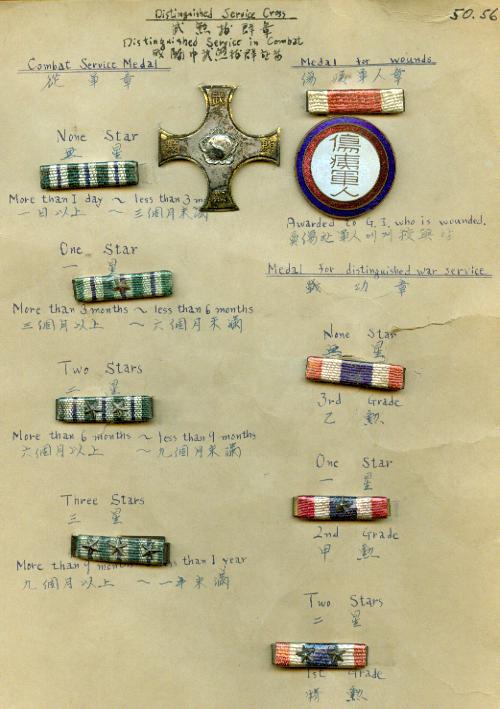
Ribbons for the Combat Service medal on the right-hand side. The Distinguished Service Cross at center top. The ribbon bar for the Wound Medal at top right. Just below is the Special-Wound Medal. The three ribbons on the right side are for the distinguished War Service Medal.
1st Infantry Division Commemorative
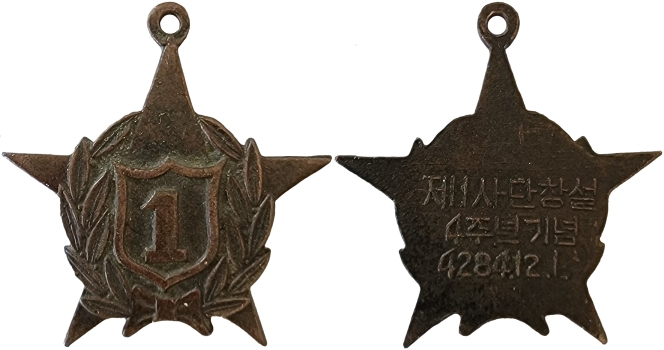
제 1 사단창설 “Establishment of the 1st Division”
4주년기념 “4th Anniversary”
4284.12.1 “Dec. 1, 1951”
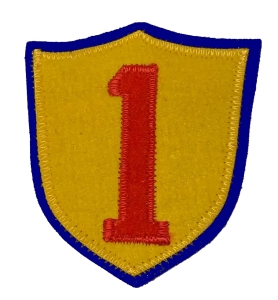
The 1st Infantry Division 제1보병사단 (第一步兵師團) is a military formation of the Republic of Korea Army’s I Corps. The division was established on Dec. 1, 1947 in Seoul, commanded by Colonel Kim Suk-won 김석원 (金錫源 1893-1978).
The 1st Infantry Division was the first ROK Army unit to be attacked by the North Koreans when the Korean War broke out on June 25, 1950. At the time, it was commanded by Colonel Paik Sun-yup 백선엽 (白善燁 1920-2020). The division, as a part of the Korean II Corps, became part of the defensive line to slow the North Korean advance from Seoul to Taejon. While many of the Korean units, broke and ran, the 1st Division withdrew while maintaining its order of battle while fighting this delaying action. This led to Paik being promoted to Brigadier General on July 25, 1950. Keep in mind that most of the Korean military units were ill-prepared and ill-equipped, not to mention that they lacked adequate leadership. The division subsequently fought in the Battle of Pusan Perimeter 부산 교두보 전투 (Aug. 4 – Sep. 18, 1950), fighting at the Naktong River (Aug. 3 – 13, 1950), the capture of Pyongyang (Oct. 19 – 20, 1950), the operation to re-recapture Seoul and the Imjin River (Feb. 7 – Apr. 30, 1951), the campaign of Tongil-Chun (May 10 – May 30, 1951), Operation Doo Mai-ri (Dec. 28, 1951 – Jan. 8, 1952), and Anti-guerilla Operations in the Honam Area; (July 13 – Aug. 6, 1952). After the armistice, the division held front-line positions along the DMZ, under the U.S. I Corps.3
Prewar Police Awards
In 1946, the U.S. Military Government in Korea (USAMGIK) reported, “The Department of Police has adopted a system of awards for bravery consisting of four citations”.4 These are: The highest award is for: “Gallantry and Intrepidity at imminent personal hazard of life and with knowledge of the risk assumed.” It is a cloth decoration containing three white stars on a yellow background, to be worn on the lower right sleeve. The other awards are for: “Personal combat with an armed opponent in the line of police duty, with an act of extraordinary heroism at imminent risk of life”, “Personal risk of life in intelligent performance of police duties”, and “Acts of personal bravery or highly intelligent police work”. There is no mention of what the other three awards looked like, but it is assumed that they were probably also cloth decorations possibly containing a lesser number of stars (or no star for the 4th citation), on a yellow background. This is all the information that I have on these awards, and because these awards were with the National Police Administration and not with the central government, there is no information readily available. I have not been able to get any cooperation from the Korean National Police.
Additional Research Projects (A.K.A. Prewar Headaches)
In 1946, the United States Military Government in Korea (USAMGIK) reported that: “The Korean Constabulary and Coast Guard personnel who served with national defense units at any time between 16 January 1946 and a date yet to be announced will be awarded the Korean National Defense Organization Service Ribbon.”5 No information is given on the design of the ribbon. There are other sources which mention an Honor Medal of the National Defense Constabulary Forces. These might be one and the same award. Additional research is required.
There are other Constabulary and Coast Guard Awards. In the same publication mentioned above, USAMGIK reports: “Other newly established decorations and awards for which national defense personnel may be eligible are”: The Constabulary Decoration for Meritorious Service and the Coast Guard Decoration for Meritorious Service. The Constabulary Decoration for Gallantry and the Coast Guard Decoration for Gallantry. The National Defense Service Injury Award. The National Defense Exemplary Service Medal for Constabulary and Coast Guard Enlisted Personnel. Unfortunately, no information is given as to the appearance of the awards or to the award criteria. Additional research is required.
On Apr. 21, 1950, Syngman Rhee, the President of the Republic of Korea, wrote a letter to the Charge d’Affaires, Mr. Everett F. Drumright at the American Embassy in Seoul. In the letter he states: “The Korean government is planning, in connection with the celebrations on Liberation Day, August 15, this year, to award a Liberation Medal and Ribbon to all members of the United States Armed Forces who served in Korea from the close of the war in 1945 until the establishment of the Government of the Republic of Korea on Aug. 15, 1948.” This offer was turned down by the U.S. government. However, with the letter having been dated for late April and the awarding scheduled less than 4 months later, it is reasonable to assume that prototype medals were made or at the very least designed. To date, no information on the design of this “Liberation Medal” has surfaced. Additional research is required.
In a follow-up letter to the U.S. State Department concerning Syngman Rhee’s offer of a “Liberation Medal”, Mr. Drumright wrote: “The Embassy further understands that at a later date, the President wishes to give an award to the Korean Military Assistance Group (KMAG) personnel, but that he wishes first to give proper recognition to the U.S. Armed Forces in Korea (USAFIK).” It is possible that, buried somewhere in the Korean archives, there may be a sketch of this proposed medal. Additional research is required.
Footnotes:
- Although I list these Awards as prewar, they were actually available for use by the military in the early days of the Korean War. It is unknown if they were actually utilized during the war.
- After the closing of the exhibition, at least part of it was moved to Gimpo Sangsang Park located in Gimpo-si, Gyeonggi-do.
- Information source: Unit’s Short History ROKA (ROKA HQ Armies Corps Division).
- Commander-in-Chief United States Army Forces, Pacific, SUMMATION OF UNITED STATES ARMY MILITARY GOVERNMENT ACTIVITIES IN KOREA, NO. 8, published May 1946, p.28
- Commander-in-Chief United States Army Forces, Pacific, SUMMATION OF UNITED STATES ARMY MILITARY GOVERNMENT ACTIVITIES IN KOREA, NO. 8 May 1946, p.30
